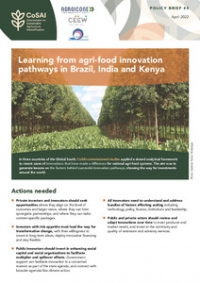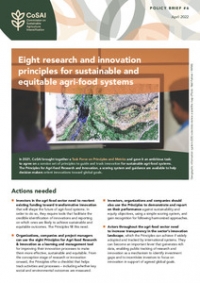Disclaimer: The opinions expressed in this blog post do not reflect the views or positions of the CGIAR Research Program on Water, Land and Ecosystems or its partners. For our full disclaimer click here.
What are we to make of the proliferation of water funds round the world dedicated to maintaining the watersheds that keep rivers flowing, aquifers charged and taps full? Should we embrace the engagement of some of the world’s most famous water guzzlers? Or should the presence of names such as Coca Cola, Pepsi and SABMiller as pump primers for these funds be a warning sign that vital hydrological commons are being privatised?
One view would be that such corporations are cynically in the business of protecting their own water needs and fragile corporate reputations. Coca Cola came badly unstuck in India after being accused of emptying the wells of neighbouring farmers to keep a bottling plant functioning.
But equally such companies have scientific expertise and deep pockets that could pay for ecological rehabilitation that benefits the water cycle in vulnerable landscapes. And perhaps we can rely on environmental NGOs such as WWF and The Nature Conservancy (TNC) that promote many of the funds to ensure fair play. Or are they too party to an ongoing water grab?
In truth, we don’t know yet. As with many of the corporate pledges made recently on deforestation and land rights, time may tell. But meanwhile, land use policies across watersheds covering vast swathes of the tropics are being taken over by public-private partnerships where water-guzzling international corporations often have the whip hand.
The Water Fund Trend
This trend began in Ecuador in 2000 with the Quito Water Fund (FONAG), which was set up by TNC to pay for upland water conservation projects – payments for ecosystem services. Other funds have followed across Latin America. There are altogether more than 12, in Brazil, Bolivia, Guatemala, Honduras, Mexico and elsewhere, and more are planned.
In 2013, I was the guest of SABMiller in the Colombian Andes, where I saw how the Bogota Water Fund, which it helped fund, was moving into the upland pastures known as paramos that soak up rain and cloud water. It was offering cattle communities cash incentives to reduce their herds to maintain these natural sponges. The ultimate aim was to protect water supplies in the faraway capital, where the company’s subsidiary and the country’s monopoly brewer, Bavaria, had a large plant.
This is important work. “Water funds are a part of TNC’s major strategy to conserve large rivers round the world,” says the NGO. But entering into partnerships with major industrial water users and polluters is a high-risk strategy. It could end up alienating the custodians of the land and water that are essential to achieving its purpose. And there are worrying signs that those custodians are not being listened to sufficiently, still less put in charge.
TNC’s guide to creating water funds identifies the importance of engaging stakeholders in the process, but barely mentions rural communities. It says that “the key stakeholders in a water fund are essentially the largest consumers of the water resources.” (see page 25)
Last month, the first water fund in Africa was announced. Called the Nairobi Water Fund, it aims to protect the upper reaches of the Tana River, Kenya’s longest river. The river rises in the Aberdare mountains and provides the Kenyan capital with some 95 per cent of its water, while generating half of Kenya’s electricity.
The new fund is masterminded by TNC and has money from Coca Cola, the Kenya Electricity Generating Company and the local subsidiary of the global drinks giant Diageo, which brews Tusker beer in Nairobi. Its prime purpose, it says, is to “educate” upland farmers in ways to reduce the soil erosion that is silting up reservoirs and making the river increasingly flashy and unable to meet the sometimes excessive demands being made on it. They will be planting trees along river banks and terracing hillsides.
Who's in charge?
Fair enough. But the governance seems deeply flawed. No farming communities sit on the fund’s steering committee, which in essence pays farmers to address priorities set by big urban and industrial water users.
Other major sources of sediment such as quarries are so far excluded from the fund’s attentions. And there is no system for addressing the needs and concerns of farmers and others downstream of dams owned by partners in the fund.
It all looks a bit one-sided, with the small farmers the fall-guys. The fund could easily become a convenient way for major water users to avoid answering questions about how they get access to the water they need while, as the fund’s own publicity material agrees, 60 per cent of Nairobi’s residents do not have access to a reliable water supply.
Last month too, water authorities in Lima, the capital of Peru, announced that they were adopting plans for rehabilitating the catchments of rivers that flow out of the Andes to supply the 9 million inhabitants of what is one of the world’s largest desert cities. The plans will include innovative ideas like paying mountain communities to rehabilitate amunas, ancient pre-Inca water channels that once diverted wet-season river flows to recharge aquifers.
In this case, the money for the work will come primarily from regular water charges. But the plans have been developed by another public-private water fund called Aquafondo, which expects to administer them. Aquafondo was founded by TNC with funding from SABMiller, whose local subsidiary runs Peru’s Lima-based near-monopoly brewer.
Again, this is potentially valuable work. And Tony Allan, veteran water researcher at Kings College London, was surely right when he told me this week that corporations such as SABMiller should be congratulated for taking the lead in addressing the water problems in the supply chains of their products.
“They know more about such things than any other interested parties in the academies, the NGO sector or in public sector policy and governance agencies,” he said. “They understand the need to help farmers to be good stewards.”
But the question remains: who is in charge? Where is the community involvement when outsiders, however expert, assume hydrological control of water on their land? Is this really the way to manage our vital hydrological commons?
Read Fred Kizito's response from the International Center for Tropical Agriculature: Water Funds: Getting the science right
Read Charles Oluchina's response from The Nature Conservancy: From Trees to Taps
Correction posted:
May 8, 2015: The Tana River provides Nairobi with some 95 per cent of its water, while generating half of Kenya's electricity.















